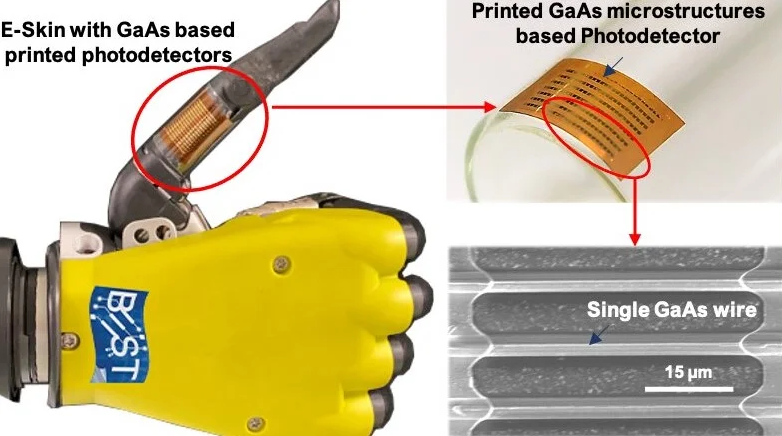Robots can ‘see’ using new type of electronic skin
A flexible photodetector could provide future robots with an electronic skin capable of “seeing” light beyond the range of human vision.

[July 20, 2022: Ayoub Zumeit, University of Glasgow]
Their material provides performance equivalent to the best conventional photodetectors on the market. (CREDIT: University of Glasgow)
A new form of flexible photodetector could provide future robots with an electronic skin capable of "seeing" light beyond the range of human vision.
A team of engineers from the University of Glasgow are behind the breakthrough development, which involves a newly-developed method of printing microscale semiconductors made from gallium arsenide onto a flexible plastic surface.
Their material provides performance equivalent to the best conventional photodetectors on the market, and are capable of withstanding hundreds of cycles of bending and flexing.
In a new paper published in the journal Advanced Materials Technologies, the researchers outline how they developed the technology, which allows the skin to detect light from a broad range of the electromagnetic spectrum.
It builds on previous research from the team in which they developed a method of printing silicon circuitry directly onto the surface of flexible plastic, which enabled the creation of high-performance bendable electronics.
Related Stories
Gallium arsenide is used in many electronic applications to create high-performance electronics. However, they have mainly been created on rigid surfaces—the Glasgow team are among the first to find a way to use gallium arsenide on a flexible substrate.
They adapted their existing roll printing system to print gallium arsenide electronics onto a flexible surface using arrays of wires that are 15 micrometers in width.
That allowed them to create a new type of flexible photodetector capable of sensing light from the ultraviolet range, through the visible portion of the spectrum, to the infrared—all of it requiring extremely low power.
The system is capable of ultrafast response to light, taking just 2.5 milliseconds to measure light and 8 milliseconds to recover—a performance as good as the best non-flexible photodetectors currently available.
Flexible photodetector could give robots new capabilities. (CREDIT: University of Glasgow)
In order to test the system's durability, they subjected the material to a rigorous set of tests in a machine designed to bend and twist it hundreds of times. Over the course of 500 cycles, the material demonstrated no significant loss in performance.
Professor Ravinder Dahiya of the University of Glasgow's James Watt School of Engineering is the leader of the Bendable Electronics and Sensing Technologies (BEST) research group, which developed the skin.
Professor Dahiya said: "We've been working for a number of years now to advance the capabilities of flexible electronics. We've found new ways to print electronics directly onto flexible surfaces, built electronic skin capable of feeling 'pain,' and developed bendable electronics which can be powered by the sun or human sweat.
Schematic illustration of GaAs microstructures-based PD fabrication process and related optical and SEM images: a) bulk (100) oriented GaAs source wafer; b) PECVD-assisted SiO2 deposition on GaAs bulk wafer; c) using patterned SiO2 as an etch mask with 40 µm length and 5 µm width; d) anisotropic chemical etching step to form GaAs microstructures; e) SEM image showing formation of GaAs microstructures after wet etching step; and f) an illustration of direct roll transfer printing of GaAs microstructures. The figure also shows an optical image of arrays of printed GaAs microstructures onto the target PI substrates and the SEM image of the donor substrate after transfer process. g) Fabricated PDs with metal deposited using conventional microfabrication steps. (CREDIT: University of Glasgow)
"This latest development is the first time we've been able to print gallium arsenide onto flexible surfaces, opening up new avenues for our research.
"In the future, this type of light-sensitive flexible material could lend new abilities to robots. Mechanical arms used for manufacturing in light-sensitive environments, for example, could become capable of detecting when conditions change and the safety or effectiveness of their work is put at risk. Flexible, broad-spectrum photodetectors could also find use in a wide range of wireless communication technologies, where the fast transmission and response speeds we've tested are always in demand."
Ayoub Zumeit and Abhishek Dahiya from the BEST group and co-authors of the paper, added: "It could even be used to develop a wearable patch for humans to use to monitor exposure to UV light during sunny days, and provide a warning when users are at risk of getting sunburned."
Note: Materials provided above by University of Glasgow. Content may be edited for style and length.
Like these kind of feel good stories? Get the Brighter Side of News' newsletter.
Joshua Shavit
Science & Technology Writer | AI and Robotics Reporter
Joshua Shavit is a Los Angeles-based science and technology writer with a passion for exploring the breakthroughs shaping the future. As a contributor to The Brighter Side of News, he focuses on positive and transformative advancements in AI, technology, physics, engineering, robotics and space science. Joshua is currently working towards a Bachelor of Science in Business Administration at the University of California, Berkeley. He combines his academic background with a talent for storytelling, making complex scientific discoveries engaging and accessible. His work highlights the innovators behind the ideas, bringing readers closer to the people driving progress.



